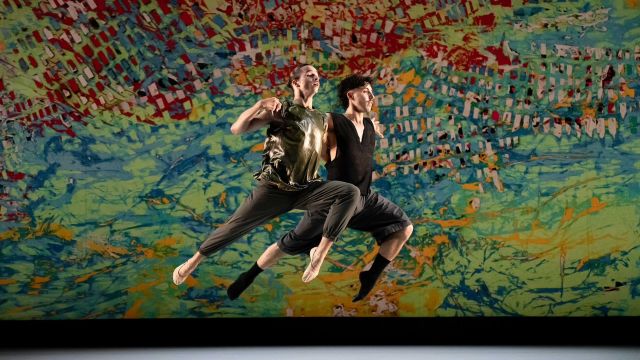Gems
French-born choreographer Benjamin Millepied, founder and director of L.A. Dance Project (est. 2011), brought a rare program of American contemporary dance to Brisbane Festival: a trilogy of works inspired by precious stones — rubies, diamonds, and emeralds. Created between 2014 and 2016, these works have been performed internationally, but their reconfiguration here into a thematic triptych marked an Australian first.
Millepied’s artistic credentials are formidable. A former student of the School of American Ballet and later a principal dancer with New York City Ballet, he was shaped by the towering figures of George Balanchine and Jerome Robbins. His career, however, extends well beyond performance: his choreography for Darren Aronofsky’s Black Swan, for example, introduced him to a wider public (and to his future wife, actress Natalie Portman).

The performance began with Reflections, created in collaboration with composer David Lang and artist Barbara Kruger. The piece unfolded as a series of vignettes for eight dancers, shifting between duets, trios, and ensemble formations with a score comprised of Lang’s solo piano works This Was Written by Hand and selections from Memory Pieces. Pianist Yangfeng (Tony) Bai, a graduate of The Colburn School in Los Angeles, gave a performance of remarkable clarity, navigating the fragmented score with unshakeable poise. Despite his sensitive playing, the music itself felt austere and inward-looking. Lang’s brand of minimalism in this selection, reduced here to brittle fragments, risks alienating rather than engaging, not really matching Millepied’s intention to capture the various emotions associated with sensual yearning and passion.
The second piece, Hearts & Arrows, shifted tone dramatically. Performed to a string quartet by Philip Glass and accompanied live by Camerata – Queensland’s Chamber Orchestra, the work sparkled with energy and theatrical flair. Costumes reflected the glint of diamonds, aligning with Millepied’s intention to replicate refracted light through movement. Glass’s music, with its driving ostinati and fluid arpeggiations, has long been a choreographic favourite: the ‘spinning-wheel’ rhythms recall Baroque composers such as J.S. Bach, their flow perfectly suited to the ebb and surge of human motion, though without the constant shifts of harmony. Unlike Lang, Glass rarely aims for cerebral provocation, rather his scores envelop listeners in waves of sound, pulses echoing bodily rhythms, being often hypnotic. Millepied responded with choreography that highlighted both ensemble unity and individual virtuosity. Dancers swept across the stage in shifting geometries, cutting diagonals and spirals with precision. The partnering was not always seamless, but there was urgency and sparkle in the movement that matched the score’s propulsion.

The trilogy concluded with On the Other Side, again to music by Glass, this time for solo piano. The stage was dominated by a vast abstract backdrop by Los Angeles artist Mark Bradford, a riot of colour and texture that contrasted with the score’s purity. Here Millepied’s choreography reached its fullest expression. The work alternated between ensemble passages, pas de deux, and solos, giving space for dancers to shift between strength and vulnerability, lyricism and sharp-edged dynamism. Themes of intimacy and distance, union and separation, unfolded against Glass’s endless cycles of sound. If Reflections was weighed down by abstraction, On the Other Side was its antidote: an expansive, emotionally resonant meditation expressing layers of love and connection in an uncertain world.
Minimalism has often divided audiences. For some, it offers transcendence through simplicity; for others, it courts monotony and self-indulgence. I fall somewhere in between. As a pianist and composer myself, I admire certain elements of Glass’s hypnotic intensity — his 1982 film score for Koyaanisqatsi, for example, remains one of my favourites. Lang’s contribution, however, left me cold, being more of an intellectual exercise lacking in genuine communication.

Despite the absence of one cast member due to injury, the L.A. Dance Project ensemble adapted with professionalism and commitment. Their teamwork was evident, though at times without the polish of the classical line. Contemporary dancers today need to embody a fusion of traditions: ballet’s clarity combined with the grounded strength of modern dance.
The evening’s unsung hero was undoubtedly Tony Bai. In Lang’s difficult and jagged score he maintained coherence, while in Glass he brought colour, phrasing, and nuance. His artistry lifted the dance and reminded us that the accompanist’s role can be as demanding, if not more, as that of any concert soloist.

Minimalism may not appeal to all tastes, but it remains an intriguing chapter in contemporary art. For Brisbane audiences it provided a rare glimpse into the dialogue between music, movement, and visual art that has shaped American dance since the 1960s. At its best, it was both challenging and rewarding — a program that showed how simplicity can generate complexity, and how repetition can be transformed into rejuvenation.
Brian Adamson
Images: Jade Ellis
Subscribe to our E-Newsletter, buy our latest print edition or find a Performing Arts book at Book Nook.

